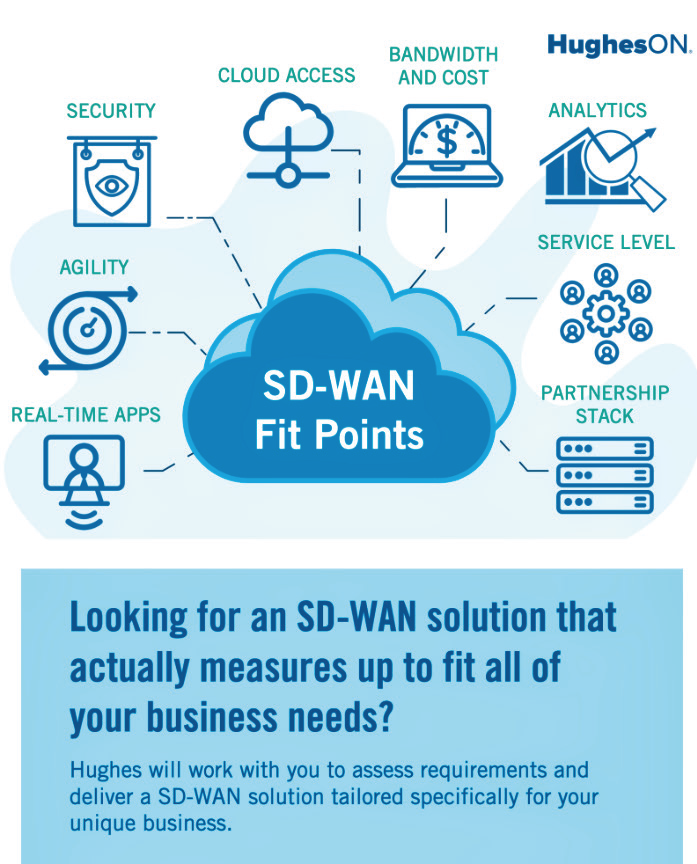Businesses everywhere — from the U.S. to Brazil to Europe to India — depend on their networks even more so now than was ever before necessary. This experience is not only due to COVID-19; however, the pandemic certainly accelerated the adoption —if not the enhancement — of distributed enterprise networks around the world.

Banks, retailers, gas stations, restaurants and even school systems and government agencies need system-wide networks to enable everything from day-to-day communications to online services for employees and customers. Yet for locations beyond the reach of cable and fiber lines, enterprise networking passes over them altogether, or depends on unreliable LTE connections. For those locations, and for entire network redundancy, satellite connectivity fills an essential services provision gap.
At the same time, enterprises are embracing software-defined, wide area networking (SD- WAN) as a way to manage distributed networks comprised of vastly different broadband access types and infrastructure while supporting the proliferation of cloud-based applications. SD-WAN can transform simple broadband connections — including cable, fiber, LTE and satellite — into enterprise-grade, high performance WANs.
In fact, with the latest generation of High-Throughput Satellites (HTS) and ground systems, businesses are increasingly using satellite connectivity to complement LTE and thereby ensuring very high availability — particularly for mission critical applications. SD-WAN solutions are evolving to include satellite connectivity and multi-transport capabilities in a single edge device, with improved network management and performance optimization.
As network usage continues to climb, the need for better network management tools also rises. At Hughes, for example, the company looked at the experiences of the firm’s customers, including nearly half a million enterprise sites under management across the globe.
In analyzing the numbers, Hughes noted that bandwidth demand per enterprise site increase by 150 percent over the past three years. In just a three- month period, looking at data from 1,900 enterprise sites, 25 percent of the branch locations experienced network congestion during daily peak hours (and that was pre-COVID). All of this data makes the case for the value of SD-WAN in delivering dynamic load sharing across multiple connections for better traffic flow.
Meeting Increased Demand with SD-WAN
Wide-area networks allow enterprises to connect remote branches to central data centers and to one another. Because of the distances between locations and the wide variety of hardware typically deployed across the sites, WANs are likely to suffer network congestion, unacceptable latency and periodic service outages. SD-WAN products solve these problems by taking over the task of data routing and overlaying the network with control policies that allow the disparate network connections to run more like dedicated circuits.
What’s more, going a step further, SD-WAN delivers dynamic load sharing across multiple connections of existing network infrastructur to better manage traffic flow. SD-WAN is carrier agnostic and weaves together wired, cellular and HTS connections into a seamless network. Cellular 4G LTE (and soon 5G) can be used for low-latency applications, while satellites can carry the bulk capacity data, giving enterprises a dual path for high- availability networking.
Automating network functions is at the core of SD-WAN, ensuring that applications are automatically identified, and that critical data is prioritized in real-time, even when encrypted. With this advanced functionality identifying and prioritizing applications automatically, new applications can be added without making network changes while ensuring that existing functionality is not impacted.
As these networks depend on broadband connectivity with variable performance characteristics, SD-WAN ensures mission critical applications get the bandwidth they need. Data compression will add virtual bandwidth to those sites struggling to meet performance demands due to bandwidth constraints.
Finally, SD-WAN delivers highly available connectivity by leveraging multiple WAN connections at the branch and seamlessly routing applications to the best performing path to ensure the best user experience.
Bringing Satellite into the Mix

The promise of an SD-WAN solution is the ability to manage network performance across every transport type. More and more, that needs to include satellite broadband, which requires integrating SD-WAN capabilities into satellite ground systems. The newest generation of satellite ground system technology interconnects seamlessly into SD-WAN solutions by combining the latest satellite technologies with cutting-edge SD-WAN technologies to yield the best of all worlds.
Advantages of deploying SD-WAN across satellite broadband sites include:
• The most efficient use of the satellite broadband thanks to innovations such as high speed TDMA on the return channel, DVB-S2X and effective protocol acceleration techniques.
• Enhanced quality of service, traffic flow control, intelligent path control and application prioritization — regardless of transport type.
• Implementation of Secure Access Service Edge (SASE) for dynamic, network-wide security so that all network endpoints, public and private cloud resources and data centers are authenticated and secured within the context of preset parameters.
Bringing together disparate types of connectivity into a cohesive network may sound daunting, but that is the value of an SD- WAN solution and the future of the multi-transport ecosystem. As an example, a chain of gas stations and convenience stores upgraded local circuits to achieve higher throughput for transaction approvals. At a test store, the circuit was provisioned to deliver .512 Mbps uplink speeds, but only delivered .39 Mbps, not enough to support both retail transactions and back-office applications. Using the same circuit and a multi- transport backup, the customer boosted throughput speeds to 3.0 Mbps, a significant improvement supporting a better end user experience.

Another company, a financial services firm with thousands of employees spread across a large geographic area, needed significantly higher bandwidth and more network availability than its legacy network could deliver. The company was working with 98 different internet service providers while also integrating new branches as the result of a merger.
A Managed SD-WAN solution for 1,600 sites and 3,200 devices has enabled significant cost savings in migrating from MPLS while surpassing its own standards for network reliability. With multi-transport terminals that support satellite and LTE, the network can extend to the farthest reaches of the enterprise – beyond where fiber and cable are available.
Now essential to a distributed enterprise, SD-WAN serves as a highly efficient and cost-effective tool for ensuring that users at the most remote ends of a network have the same connectivity experience as all others on the network, no matter what type of transport they are using.
www.hughes.com

Author Sharyn Nerenberg is the senior director of corporate marketing and communications at Hughes and she leads the company’s public relations and thought leadership efforts across consumer, enterprise, government and international business lines. She brings more than two decades of corporate communications and marketing experience and is passionate about evangelizing the role of satellite in enabling the connected experience. Ms. Nerenberg serves on the board of directors of Space & Satellite Professionals International (SSPI) and co-chairs the Communications Working Group of the Satellite Industry Association.

Author Dave Rehbehn is the vice president responsible for global marketing of Hughes broadband products and services. In this capacity, he develops Hughes market strategy, including product and service offerings, and is responsible for the strategic direction for the Hughes international sales force. Mr. Rehbehn works extensively with end users and service operators to track market trends, including application and business developments, and their impact on networking solutions. Mr. Rehbehn has more than 26 years of experience in the satellite arenaincluding business development for the Hughes set-top box product family, as well as the Hughes consumer Internet service business.



